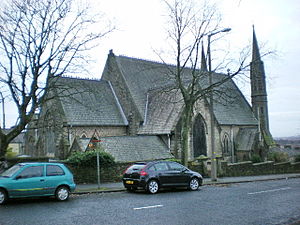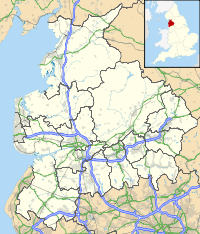- Christ Church, Lancaster
-
Christ Church, Lancaster 
Christ Church, Lancaster, from the northeastLocation in Lancashire Coordinates: 54°02′45″N 2°47′18″W / 54.0458°N 2.7883°W Location Wyresdale Road, Lancaster, Lancashire Country England Denomination Anglican Website Christ Church, Lancaster History Founder(s) Samuel Gregson Architecture Status Parish church Functional status Active Heritage designation Grade II Designated 13 March 1995 Architect(s) Henry Martin, Paley and Austin Architectural type Church Style Gothic Revival Groundbreaking 1855 Completed 1889 Specifications Materials Sandstone, slate roofs Administration Parish Lancaster Christ Church Deanery Lancaster and Morecambe Archdeaconry Lancaster Diocese Blackburn Province York Clergy Vicar(s) Revd Philip Simon Hudd Christ Church, Lancaster, is in Wyresdale Road, Lancaster, Lancashire, England. It is an active Anglican parish church in the deanery of Lancaster and Morecambe, the archdeaconry of Lancaster, and the diocese of Blackburn.[1] The church has been designated by English Heritage as a Grade II listed building.[2]
Contents
History
Christ Church was built between 1855 and 1857 to a design by the London architect Henry Martin.[3] It was built as a chapel for Lancaster Grammar School and the local workhouse.[1] The church was paid for and endowed by Samuel Gregson, a local industrialist and MP. The nave and transepts were extended by the local architects Paley and Austin, who added a baptistry to the west in 1871–72, and the south aisle in 1889.[2][3]
Architecture
Exterior
The church is constructed in squared coursed sandstone and has slate roofs. Its plan consists of a nave, a west baptistry, a north porch, a north transept, a north vestry, a chancel with a lower roof, a south aisle with a chapel, and a south porch. At the west end is a pair of turrets. Most of the windows in the church have pointed arches and contain Geometric tracery. The turrets have square bases that broach to octagons. The bell openings are gabled and above them are spirelets. At the west end of the nave is a five-light window containing Perpendicular tracery. Beneath the window and between the turrets is the baptistry.[2] Springing from the baptistry are gargoyles.[3] At the west end of the south aisle is a three-light window. The south aisle is in six bays separated by buttresses. Five of the bays contain two-light windows with trefoil heads. The sixth bay, probably the site of an earlier transept, contains a three-light window. On the north side of the church is a porch, with one bay to the west and three bays to the east, all with two-light windows. In the north transept, the north window has three lights, and the west window two lights. The north wall of the vestry contains a four-light mullioned window and a doorway; the east wall has two two-light windows. In the east wall of the chancel is a three-light window; the south aisle and chapel each have two-light windows, and in the south wall of the chapel are two two-light windows.[2]
Interior
Between the nave and the south aisle is a four-bay arcade. The font, dating from 1914, is made from sandstone and marble. It has a wooden cover, carved as a Gothic spire. Over this is a wrought iron crane with an ornate arm.[2][3] The reredos is in marble and dates from 1916.[3] Some of the stained glass was made in the middle of the 19th century by Powell.[2] Elsewhere there is a "magnificent scheme" of stained glass by Shrigley and Hunt, installed between 1892 and 1909, described in the Buildings of England series as "one of their best and most important ensembles".[3] The three-manual organ was installed in 1857, and was rebuilt, enlarged and moved into the north transept in 1937 by Henry Ainscough of Preston.[4]
External features
To the north of the church is a sandstone war memorial dating from about 1920. It has also been designated as a Grade II listed building.[5]
See also
- List of ecclesiastical works by Paley and Austin
References
- ^ a b Christ Church, Lancaster, Church of England, http://www.achurchnearyou.com/lancaster-christ-church/, retrieved 23 July 2011
- ^ a b c d e f "Christ Church, Lancaster", The National Heritage List for England (English Heritage), 2011, http://list.english-heritage.org.uk/resultsingle.aspx?uid=1214919, retrieved 23 July 2011
- ^ a b c d e f Hartwell, Clare; Pevsner, Nikolaus (2009) [1969], Lancashire: North, The Buildings of England, New Haven and London: Yale University Press, pp. 407–408, ISBN 978-0-300-12667-9
- ^ Lancashire, Lancaster, Christ Church (N01994), British Institute of Organ Studies, http://www.npor.org.uk/cgi-bin/Rsearch.cgi?Fn=Rsearch&rec_index=N01994, retrieved 23 July 2011
- ^ "War memorial approximately 5 metres north of Christ Church, Lancaster", The National Heritage List for England (English Heritage), 2011, http://list.english-heritage.org.uk/resultsingle.aspx?uid=1298335, retrieved 23 July 2011
Categories:- Church of England churches in Lancashire
- Grade II listed churches
- Grade II listed buildings in Lancashire
- Diocese of Blackburn
- Paley and Austin buildings
- Gothic Revival architecture in Lancashire
- Buildings and structures in Lancaster
Wikimedia Foundation. 2010.

